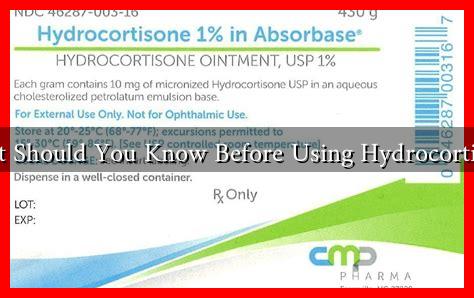-
Table of Contents
What Should You Know Before Using Hydrocortisone
Hydrocortisone is a widely used corticosteroid that helps reduce inflammation and alleviate symptoms associated with various skin conditions, allergies, and autoimmune disorders. While it can be highly effective, it is essential to understand its uses, potential side effects, and proper application methods before incorporating it into your treatment regimen. This article aims to provide a comprehensive overview of what you should know before using hydrocortisone.
Understanding Hydrocortisone
Hydrocortisone is a synthetic form of cortisol, a hormone produced by the adrenal glands. It is available in various forms, including creams, ointments, lotions, and oral tablets. Hydrocortisone works by suppressing the immune response and reducing inflammation, making it effective for treating conditions such as:
- Psoriasis
- Eczema
- Allergic reactions
- Dermatitis
- Inflammatory bowel disease
When to Use Hydrocortisone
Hydrocortisone is typically recommended for short-term use to manage flare-ups of inflammatory conditions. It is crucial to consult a healthcare professional before starting treatment, especially if you have underlying health issues or are taking other medications. Some common scenarios where hydrocortisone may be prescribed include:
- Localized skin irritations
- Severe allergic reactions
- Post-surgical inflammation
- Chronic skin conditions
Potential Side Effects
While hydrocortisone can be beneficial, it is not without risks. Prolonged or excessive use can lead to several side effects, including:
- Skin thinning and fragility
- Stretch marks
- Increased risk of infections
- Systemic absorption leading to adrenal suppression
- Changes in skin pigmentation
According to a study published in the Journal of Dermatological Treatment, long-term use of topical corticosteroids can lead to significant skin changes, emphasizing the importance of using hydrocortisone as directed.
Proper Application Techniques
To maximize the benefits of hydrocortisone while minimizing side effects, proper application techniques are essential. Here are some guidelines to follow:
- Apply a thin layer to the affected area, gently massaging it into the skin.
- Wash your hands before and after application to prevent contamination.
- Avoid using hydrocortisone on broken or infected skin.
- Do not cover the treated area with bandages unless directed by a healthcare provider.
- Limit use to the recommended duration, typically no more than two weeks for topical forms.
When to Avoid Hydrocortisone
There are specific situations where hydrocortisone should be avoided or used with caution:
- If you have a known allergy to hydrocortisone or any of its components.
- In cases of viral infections, such as herpes or chickenpox.
- For fungal infections, as hydrocortisone can exacerbate the condition.
- In children, as they may be more susceptible to side effects.
Consulting a Healthcare Professional
Before starting hydrocortisone, it is crucial to consult with a healthcare professional. They can provide personalized advice based on your medical history and current health status. Additionally, they can recommend alternative treatments if hydrocortisone is not suitable for you.
Conclusion
Hydrocortisone can be an effective treatment for various inflammatory conditions when used correctly. However, understanding its potential side effects, proper application techniques, and when to avoid it is essential for safe and effective use. Always consult a healthcare professional before starting any new medication, including hydrocortisone, to ensure it is appropriate for your specific needs. By being informed and cautious, you can harness the benefits of hydrocortisone while minimizing risks.

